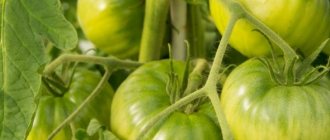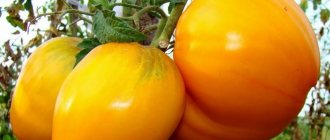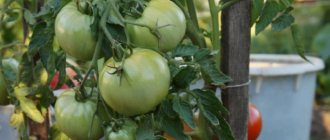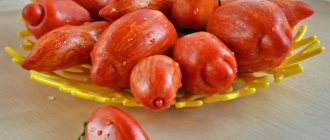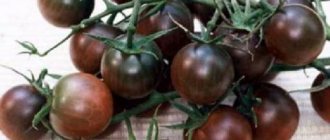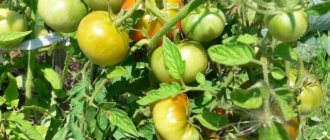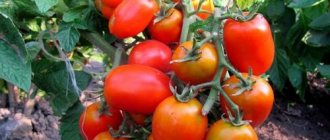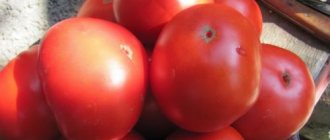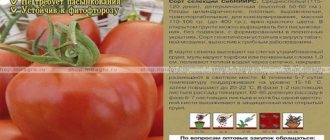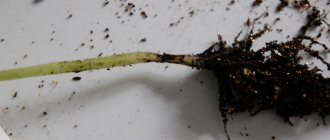general information
The variety “King of the Early” is not listed in the register of breeding achievements of the Russian Federation, Ukraine and Belarus.
This “king” is packaged with the indication “Our selection”. At the same time, who the author and originator of the variety is is not indicated, but there is a note that the selection is Agro.
It is no secret that introducing a variety into the register of breeding achievements is not easy, and it takes time. Perhaps in the future the variety will be tested and the commission will allow it to enter the register, but so far this has not happened.
Agro markets the variety as an early ripening variety with the ability to grow in indoor and open ground.
There is another packer on the market. “King of early” tomato from “Siberian Garden”, reviews indicate, and the manufacturer himself says that the tomatoes are early and raspberry in color, and its yield is up to 4 kg per bush.
Care
After germination, 2 months must pass before the seedlings can be planted in a garden bed or greenhouse. Plant only in warm soil, warmed to +16-18 °C.
Watering
The frequency of watering depends on the size of the bush and the number of fruits. The taller and more powerful the plant, the more water it requires. You can tell that the soil needs moisture by the fact that the soil around the tomato is cracking. The earthen clod should not be allowed to dry out completely.
After watering, when the water is well absorbed into the soil and the plants are saturated with moisture, it is recommended to loosen the soil to ensure air access to the root system.
Stepson and garter
To obtain a rich harvest, the plant needs tying and pinching. The formation of a bush is carried out in 1-2 stems, so excess tips need to be pinched. Over time, new stepsons appear on the bushes, which will have to be removed 2-3 times during the growing season.
Why do you need to tie up tomatoes?
Tied tomatoes receive more natural light, air circulates well between the bushes, which prevents the plants from getting sick. Another advantage of growing on a trellis: the plants do not break under the weight of their fruits.
Tying methods:
- to a wire frame;
- to a horizontal trellis;
- it is possible to make a fence from wire;
- installing pegs next to tomatoes;
- to the grid.
Vegetable growers recommend tying them to a trellis. This method will protect the fruits from damage and will support the plants during their rapid growth.
Fertilizer and feeding
The King of Kings responds well to fertilization. Before planting, it is necessary to take into account crop rotation. Phosphorus and potassium fertilizers must be added to each hole.
During the entire growing season, plants need to be fertilized with organic matter. You can use infused chicken manure, diluted in water, or mullein. An extract from mineral fertilizers will not hurt.
Growing a variety in a greenhouse
The variety is recommended to be grown indoors, especially if the climatic conditions are not warm enough. The large-fruited hybrid is very demanding on temperature conditions and does not tolerate daytime and nighttime temperature changes, so it is better not to risk the harvest and grow it in film greenhouses.
What's good about the King of the Early Ones?
The most important advantage of this wonderful tomato is its early ripening. But along with this characteristic, gardeners value the King for the following qualities:
- High yield.
- Possibility of obtaining large fruits in the early stages.
- Excellent taste of tomatoes.
- Beautiful appearance of the fruit.
- Versatility of use (not every tomato in this category is suitable for canning).
- Good keeping quality.
In the conditions of regions of risky farming, the Early King has proven itself to be excellent when grown under shelters in greenhouses.
Gardeners in Astrakhan and the Krasnodar Territory are happy to grow this variety in open ground.
Reviews
★★★★★
Victoria, 32 years old. I bought the King of Kings 2 years ago.
I liked the variety, very tasty, moderately sour and very meaty. The salads turn out wonderful. But here’s what I noticed: if you leave only 1 stem, the tomatoes turn out larger than with 2 or more stems. I even had tomatoes weighing 800-900 grams. ★★★★★
Nazar, 43 years old. Not a bad variety, this King of Kings, but I don’t like the fact that you have to buy seed material every year.
That's how many times I tried to plant my own seeds, I couldn't get the same tomatoes - the taste, color, and shape weren't the same. But despite this drawback, I still grow this tomato every year. I just want to warn you that you need to buy seeds from trusted producers, because once out of 40 seeds, only 7 of them hatched for me. Now I only take from the Siberian Garden. Tested, high quality, I recommend. ★★★★★
Lydia, 56 years old. Although I consider the variety to be late, I grow it all year round.
I equipped a winter greenhouse for this, and there were no problems. The tomato has excellent taste, meatiness, but not enough juiciness. I always grow it in 2 stems, because when I grow it in one, the fruits grow too large (one salad is enough for a plate). I also like the fact that the tomatoes ripen gradually, rather than all at once, so you can enjoy them for a long time. Hide
Add your review
The King of Kings tomato is intended for greenhouse cultivation, but it is possible to grow a tomato in open ground under appropriate conditions (enough heat and light). Many gardeners recommend this variety even to beginners, since it does not require much effort in caring for and cultivating. It does not need to be transplanted into a greenhouse before diving into the garden.
0
0
Copy link
Characteristics and description
The vegetative form of tomato is compact, low-growing, determinate. The manufacturer indicates that each tomato cluster bears 3-5 fruits.
The fruits are large, weighty, reaching 200 g and have a flat-round and rounded shape. Moreover, the same bush can bear both perfectly round, smooth fruits and flattened ones with slight ribbing.
The color of a fully ripened tomato is intense red.
The manufacturer describes the taste as “good”, and vegetable growers agree with this assessment. The fruits are fleshy, without voids, with a small seed content.
The yield of the agro variety is not indicated, but vegetable growers say that each bush bears 5-6 fruits. At the same time, there is only one large fruit, 180-200 each, the rest of the fruits are smaller. On average, you can take about 600-700 g from a bush.
Since the variety grows compactly, 5 plants can be planted per square meter. Consequently, the yield will be in the range of 3.5-4 kg.
Of course, the yield is not at all great. Perhaps this is precisely the reason for not introducing the variety into the register.
Description of the tomato King of the Giants
- Ripe tomatoes are yellow in color and heart-shaped.
- They are quite large in size, 400-600 grams, but there are also real giants, 800 grams each.
- Number of cameras 6-7.
- Dry matter content is 5-6%.
These tomatoes are very good fresh. They also make a very tasty, vitamin-rich juice. They are not used for preservation because they are too large. Representatives of this tomato variety are also very good in barrel pickling. The Early King tomato was bred a little over a decade ago in Russia. It is recommended to plant it in a greenhouse in the middle zone and cold regions, and in open ground only in the southern regions: Krasnodar Territory, Astrakhan Region. Also in the middle zone, a greenhouse can be replaced by a film shelter.
Characteristics of the bush: determinate, but sometimes they are classified as semi-determinant. They can reach 70 cm in height, but usually 50-60 cm. Fruit ripening occurs in the greenhouse already on the 85-90th day after seed germination, in open ground - on 90-95 days.
Description of the fruit: large, weighing about 200 g, round or flat-round in shape and red in color. Individual tomatoes reach 300 g. The skin is strong, but quite thin, the flesh is fleshy. There are a maximum of 7 chambers with seeds inside. The taste is excellent, especially for an early tomato. Tomatoes are suitable for fresh consumption, cooking, sauces and pastes.
Early King tomatoes contain a lot of dry matter, so they are well stored and transported, which, coupled with their yield, makes them suitable for sale.
Important! The long stem of the King of the Giants is actually quite fragile, and therefore a tomato of this variety must be tied up as it grows.
The bush is initially spreading, needs shaping (the best results are obtained when growing it in one or two stems) and pinching, since it forms lateral shoots very actively.
The leaves of this variety have a classic tomato appearance - green plates, without wrinkles.
Flower clusters are formed densely (usually after 3–4 leaves). After the sixth or seventh cluster appears, the stem should be pinched.
The ovaries begin to appear after the ninth permanent leaf has formed. Their number must be standardized.
As for the ripening period, reviews of the King of Giants tomato mainly characterize it as medium and medium-late, yielding a harvest in July–August. There is also information that the variety is an early ripening variety, but this data has not been confirmed. The ripening period of tomatoes from the moment the plant fully germinates, according to various sources, varies from 110 to 150 days.
Description of fruits
The name “King of the Giants” is intended to draw attention to the very large size of the fruits of this tomato. Advertising descriptions of seed producing companies assure that the average weight of a ripe tomato of this variety is about 0.5 kg. The largest fruits, ripening in the lower part of the plant, allegedly “break records” in weight: from 800 g to a whole kilogram.
Important! Based on reviews, the King of Giants tomato variety can produce the large weight fruits stated in the advertisement if only 1–2 ovaries are left on each cluster. Under ideally favorable agrotechnical conditions, it is theoretically possible to get giant tomatoes from a bush growing in protected ground, but there will be no more than 5–6 of them. Even with the most optimal outcome, the resulting harvest is unlikely to justify the effort spent on it.
The same uncertainty exists with regard to color. It is mainly characterized as “kumachovy” (bright red), but raspberry and even yellow tomatoes are also mentioned under this name.
However, there is something on which farmers who describe the King of Giants variety are almost unanimous - this is the excellent taste of the fruit. Their flesh is fleshy, dense and juicy. In ripe tomatoes it is sweet with a pleasant, slightly pronounced “sourness”.
Warning! If the King of the Giants tomato is overripe, its taste becomes “sugary”.
Inside, the pulp is divided into 6–8 chambers. The tomato skin is smooth and dense, but not rough. As a rule, it does not crack (however, prolonged waterlogging or extreme heat can cause this effect).
The characteristics and description of the King of Giants tomato variety will be incomplete without data on the yield and economic purpose of these tomatoes, information on the plant’s resistance to pests and diseases, as well as a brief listing of its advantages and disadvantages.
The yield indicators of this variety are declared high. With proper care, 1 King of the Giants tomato bush can produce up to 8 kg of fruit. Considering that for 1 sq.m. It is recommended to plant 2-3 plants per plot; ideally, it is possible to collect up to 24 kg of tomatoes from this area.
Important! Reviews from gardeners in general do not confirm the information about such large yields.
The keeping quality and transportability of the King of Giants tomatoes is considered average.
Vegetable growers agree that this tomato is excellent for fresh consumption. These tomatoes make excellent salads, various sauces and juice. They are great for winter preparations like ketchup or lecho. At the same time, it is not possible to pickle or preserve King of Giants tomatoes in pieces - during the heating process, their pulp tends to “spread”. They are also not suitable for blanks as a whole, since they are too large.
It is believed that the King of Giants tomato is weakly susceptible to bacterial and fungal infections - in particular, it is immune to viral tobacco mosaic and various types of rot.
As for insect pests, whiteflies can cause significant damage to tomatoes of this variety.
To combat it, it is recommended to spray the bushes with Confidor, diluting 1 ml of the drug in 10 liters of water.
Advantages DisadvantagesLarge fruitAdvertising characteristics given by companies that sell seeds do not always correspond to realityGood yield indicatorsSeedlings require painstaking careExcellent taste of tomatoesIt is necessary to tie up the bushesHigh resistance to common tomato diseasesPlants need frequent and regular feeding
The King of Giants tomato is unlimited in growth, the bushes reach a height of 150-180 cm. In open ground it grows slightly lower - up to 160 cm. The bush is standard, the leaves are ordinary, not wrinkled. The first brush appears above the ninth leaf, and then every 3-4. Maturation is mid-season, closer to mid-early - 110-115, sometimes 120 days after emergence.
The fruits of the King of Giants variety correspond to the name - one tomato can weigh up to 800 g, but on average their weight is 300-600 g. They have a bright red color, a flat-round shape, and contain 7-8 chambers with seeds. The stalk has no spot. The tomatoes are juicy, fleshy, taste sweet and sour, but the sourness is weak. The skin is dense and not prone to cracking.
The King of Giants salad variety is also suitable for processing for juices and sauces. Due to their large size, the fruits can only be preserved chopped, as part of vegetable mixtures.
The variety contains few acids and many vitamins, so it is optimal for inclusion in the diet menu and baby food.
How to grow tomatoes
After 2 months, the seedlings are ready for transplanting . They are transplanted into protected structures 2 weeks earlier than into open beds. The soil temperature is 15-17 °C. If the soil has not warmed up to this point, replanting should be delayed. In cold soil, seedlings will not grow, and the root system may suffer.
Landing
Planting pattern : 50-70 cm is the distance between seedlings, 70-90 cm is left between rows. For 1 sq. m place no more than 3 plants. Tomato branches are spreading, so it needs a lot of space. If the bushes are planted more densely, they will require more attention in the future.
They are transplanted into previously prepared holes 15-20 cm deep , at the bottom of which wood ash and a pinch of mineral fertilizers are first placed. After transplantation, the holes are compacted, watered with warm, settled water and left to adapt to the new conditions for 7-9 days.
Reference! During plant adaptation, they are not watered or fed.
Further care for the King of Early tomato
Regular watering is established no more than 2 times a week . If the crop is not watered for a long time or, conversely, the soil is over-moistened, then the fruits will crack when ripe. Water with warm water, at the root, in the morning or evening. The culture responds well to drip irrigation. To do this, place a regular plastic bottle without a bottom in the root zone and fill it with water, which gradually penetrates to the roots of the tomato.
After watering, the soil is loosened and weeds with roots are removed . Removing weeds is an important step in tomato care. Bacteria, spores and many insect pests multiply in weeds. And since plants are poorly protected from fungal diseases, timely preventive measures are crucial. In addition, loosening ensures better penetration of oxygen to the roots, which strengthens and improves immunity.
To keep the beds moist longer, use mulching . Peat, straw or sawdust serve as mulch. Mulching is also a protective measure: it protects bushes from insects living in the ground.
The variety requires feeding in large quantities . Fertilize once every 2 weeks. With weak growth, the amount of fertilizing is increased, making priority with a predominant nitrogen content. Conventional fertilizers consist of a full range of mineral fertilizers or organic matter. As organic matter, use mullein infusion or bird droppings infusion in a ratio of 1:15.
Reference! It is not recommended to fertilize tomatoes with fresh manure, as this will provoke an increased growth of green mass.
On hot days, tomato bushes are shaded to avoid burns of the leaf blades.
Features of care and possible difficulties
Due to the large number of side shoots, determinate bushes require regular pinching . Unnecessary shoots not only create shade and prevent air penetration, but also take away a large amount of nutrients. It happens that too many ovaries form on fruit-bearing branches. If they are not removed, then all the vegetables will not be able to ripen.
Despite the strong stems, the bushes require obligatory garter , otherwise the branches will break from the multitude of vegetables. In addition, the weight of the fruit bends the hands to the ground, which leads to contact with the ground. Ripening vegetables can rot and cause the spread of fungal infections.
Resistance to diseases and pests
Varieties of Siberian selections are distinguished by their resistance to fungal diseases and resistance to changes in weather conditions.
Those who grew tomatoes in greenhouses cannot say that tomatoes are affected by diseases. However, gardeners who grew the “king” in the garden are also very pleased with the results.
Advantages and disadvantages
The “King of the Early” tomato has several advantages:
- early fruiting and ripening;
- large fruit;
- resistance to diseases and weather conditions.
Among the disadvantages of this variety:
- low yield;
- need for tying and fixation.
Nuances for open and protected ground
It is not worth saving space on the site and planting tomato bushes too densely , since in the future it will require difficult care. It is necessary to constantly tear off the lower leaves and lateral shoots, otherwise the plants will not receive enough light and nutrients.
Dense plantings require more frequent feeding, once every 10 days . Fertilizers consisting of a full complex of mineral fertilizers are alternated with organic matter. From organic matter, diluted mullein infusion or bird droppings are used.
Greenhouse plants grow a little taller than street ones , but pinching the tops is not required: they grow up on their own.
Reference! Termination is the cessation of growth after the formation of a certain number of branches.
Vegetables are prone to cracking when underwatered and overripe . But you shouldn’t allow the beds to become waterlogged either - this leads to the development of fungal diseases. The best solution to the problem is drip irrigation and mulching of the beds. These agricultural practices will help avoid excess and lack of moisture.
Data
Designed for open planting in the Astrakhan, Kursk regions, and Krasnodar Territory. The regions of the far north are not suitable for this variety, but as a result of selection, the Siberian climate has become native to it. Among the main features are:
- ripe fruits have a characteristic red color;
- average weight 150 – 200 grams;
- multi-chamber - their number reaches 7;
- has a round shape;
- seed content - up to 5%.
The largest fruits are harvested 80–90 days after planting. Their weight reaches up to 500 grams. The rest of the harvest is medium-sized fruits. From one bush you can harvest up to 4 - 5 kg of wonderful tomatoes. For 1 sq. m there are usually 3 - 4 bushes. Average yield per 1 sq. m - up to 12 kg.
Taking into account the description of the variety and its characteristics, it is possible to plan fruit processing in advance. A vegetable garden and an orchard can be kept in the same area, but the plants will bear fruit at different times. Garden crops are processed separately as they ripen. The first tomatoes are convenient to use for making fresh salads or juice. The rest of the harvest is suitable for canning.
Features of growing the variety
The manufacturer indicates that the variety is early. Given this indicator, seed sowing can be done at the end of March.
Growing seedlings
In order for the seeds to germinate quickly and quickly, they need to be “revived.” To do this, just put the seed in a damp cloth, then in a plastic bag and send it to a warm place for 2-3 days.
As time passes, when you open the package, you will immediately see living seeds with signs of life and these are the seeds that should be sown.
Let's prepare the soil
You can purchase a universal soil mixture for growing seedlings or prepare it yourself. For this we use:
- fresh humus;
- herbal compost;
- garden soil.
The humus can be from any farm animals, but it must be mature and have lain for at least 1.5 years. The compost must be structured, homogeneous, sifted. Garden soil is taken from the garden, but only from those places where nightshade plants have not grown in the last 2-3 years.
For each bucket of this mixture, add two tablespoons of superphosphate and ammonium nitrate, mix well and let stand for 2-3 weeks.
Sowing
We sow in bowls using the group method. For this:
- Fill the bowl with soil to 3-4 cm;
- Compact;
- Place the seeds 2-3 cm apart;
- Cover with 1-1.5 cm of soil;
- Pour warm water through a strainer or spray with a spray bottle;
- Cover with glass or plastic wrap;
- Place in a warm place for germination.
If the temperature is optimal (24-26 ᵒC), seedlings will appear in 4-5 days. At the first signs, the bowl is placed in the brightest place, and the temperature is lowered to prevent the seedling from stretching out.
Picking
As soon as two true leaves are formed, a dive is carried out. In order to transform the tap root system of a tomato into a fibrous one, to make it more extensive for the absorption of nutrients, you need to tear off the root by 1/3.
Next, we plant the plant in an individual cup filled with a nutrient mixture right up to the cotyledon leaves.
When planting, you need to ensure that the individual pot is initially filled only 2/3 with soil. When the shoot grows, the soil will be replenished, and the stem will be able to form an additional root system.
Transplantation into the ground
The optimal age for transplanting seedlings into soil is 55-65 days. If the seedlings are in individual pots, then they tolerate transplantation well. You can replant in a greenhouse at any time, but to plant in open ground you need to wait until the period when return frosts are no longer possible.
Since the variety is early and will quickly begin flowering and fruiting, a feature of its replanting is the preparation of the site. Any vegetables except nightshades can be a predecessor for the crop, but there is a special requirement for the place of cultivation, it must be:
- sunny;
- protected from winds;
- with light, nutritious soils.
When replanting, it is necessary to ensure the nutritional status of the soil. To do this, in the place where the seedlings will be planted, it is better to select a certain amount of soil and add a pre-prepared nutrient mixture there.
Preparing and germinating seeds
Experts and breeders recommend growing the King of Kings tomato variety using seedlings. The fact is that with such cultivation it will be possible to obtain a higher quality harvest. And the tomatoes will ripen much faster. Moreover, the bushes will have increased resistance to all kinds of fungal and infectious diseases.
- First you need to purchase quality seeds from the store. It is advisable that they have already been treated with a special product that promotes rapid germination and protects against insect pests and fungi. Be sure to check the integrity of the seed packet.
- If the seeds are not treated with anything, they must be prepared before sowing in the ground. To do this, you need to dilute a weak solution of potassium permanganate and use it to thoroughly rinse all the seeds. And then you need to soak them in any growth stimulator for about 24 hours.
- Particular attention should be paid to the quality of the soil in which you plan to sow the seeds. The formation of healthy tomato bushes will largely depend on this. According to reviews from gardeners who already have some experience in growing King of Kings tomatoes, the best option is a store-bought ready-made soil mixture. It already contains all the microelements necessary for tomatoes.
- In order for seedlings to appear simultaneously from all seeds, it is recommended to deepen the seeds to the same depth, trying to maintain approximately equal distance between them. The optimal depth is 0.5 cm. You should not dig them in too much, as otherwise they will take much longer to sprout.
- As soon as 2-3 true leaves appear, you can pick the seedlings. It is recommended to plant plants in separate containers when growing in a greenhouse. As for open ground, tomatoes should be planted when there are no longer night frosts. And at first it is still better to keep the seedlings under a film so that they have time to get stronger.
To get early and abundant fruiting, timely:
- watering;
- feeding;
- mulching;
- formation;
- fungicide treatment;
- tying up shoots.
Watering
The plant's root system can only consume nutrients from the soil in dissolved form. As soon as the soil under the bush dries out, growth stops and cell aging begins. To avoid such processes, timely and regular watering is necessary.
How to grow seedlings
Sowing seeds for seedlings begins 2 months before planting in the ground . For planting, seed material can be prepared independently, since the tomato is varietal, which means it retains its parental properties in the next generation.
About other varieties of tomatoes:
Advantages and disadvantages of the Raspberry Elephant variety
Tasty, juicy and aromatic giant - the “Ox Heart” tomato
“Skorospelka” - a variety for a rich, tasty, early harvest of tomatoes
Seed preparation
The seeds are carefully inspected for visible damage , laid out one at a time on the table. They are then checked for emptiness in the saline solution. The solution is prepared from 1 spoon of salt dissolved in a glass of water. Those grains that float to the surface are not suitable for sowing.
Seed material must be disinfected , especially those collected independently. Disinfection will not only strengthen the immunity of sprouts, but will also identify non-viable plants at the initial stage. For disinfection, prepare a weak solution of potassium permanganate and place the seeds in it for 20 minutes. Afterwards they are thoroughly washed and dried.
Advice. To improve seedlings, growth stimulants or melt water are used, in which the seed is soaked for 12 hours. The swollen seeds are ready for sowing.
Container and soil
The royal tomato requires fertile and nutritious soil . It is prepared from garden soil mixed with humus and peat. For lightness, add a little washed river sand. After thoroughly mixing all the components, the resulting mixture is poured with a hot solution of potassium permanganate to destroy pathogenic flora.
Disinfected soil has a beneficial effect on the growth and development of seedlings . Then the soil is laid out in planting containers, at the bottom of which small drainage holes are made. Also, sawdust or small pebbles are placed at the bottom of the containers as drainage.
You can plant either in a common wooden box or in individual containers , for example: plastic cups, peat pots, paper honeycombs. The most convenient way to propagate seedlings is in peat pots. When grown in these containers, replanting into beds is not required; seedlings are planted in holes along with peat pots. They dissolve in the soil, additionally feeding the young roots with useful substances.
Sowing
The seeds are sown to a depth of 1.5 cm with a distance of 2-3 cm from each other , sprinkled with soil on top, slightly moistened with warm, settled water using a spray bottle and covered with film or glass to create a greenhouse effect. Until the first shoots, the planting containers are kept in a warm and bright room at a temperature of at least 25 °C. The film is periodically removed to ventilate the soil.
Seedling care
After the emergence of seedlings, the containers are moved to a well-lit place, on the windowsill.
Important! Seedlings must be provided with sufficient light. Otherwise, the stems of the sprouts will begin to stretch and the bushes will weaken.
Daylight hours for seedlings are 15-16 hours . If there is a lack of natural light, add phytolamps. Additional lighting must be taken care of in advance so that the first shoots immediately receive the required amount of light.
Water as the top layer of soil dries , without flooding the sprouts, carefully along the edge of the nursery with warm, settled water using a shallow watering can. After watering, the soil is loosened superficially so as not to touch the young roots.
During the seedling period, liquid fertilizers are applied twice for young tomatoes. This feeding is necessary for the full formation of young plants.
After 2-3 true leaves appear, the seedlings are planted , planted in separate containers. If the seedlings are left in a common box, then the distance between the bushes is increased to 10-15 cm.
Reference! Transplanting into separate containers is convenient for further transportation of seedlings to summer cottages.
2 weeks before planting, seedlings begin to harden . To do this, they are taken outside for 40 minutes - 1 hour. Gradually, the time spent outdoors is increased to 13 hours. Simultaneously with daytime hardening, the night temperature in the room is reduced to 13 °C.
Tomato King of the Early. Altai seeds
Harvesting and application
The collection of “royal” tomatoes begins in August. The first fruits are especially large and are excellent for fresh consumption. They are used to make salads, a variety of snacks, hot and vegetable dishes. Ripe vegetables are processed into tomato products and used for preparing winter preparations: marinades and pickles. Yellow vegetables look especially beautiful in jars with red ones.
It is not necessary to wait for vegetables to fully ripen; they are able to gain color on their own at room temperature. This quality is especially valued in regions with short summers.
Due to their high glucose content, which imparts a sweet taste, vegetables are suitable for baby food. They are also recommended for allergy sufferers and for dietary purposes.
